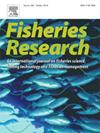Time series of otolith growth patterns reflects oxygen depletion tolerance in an abundant mesopelagic fish species
IF 2.2
2区 农林科学
Q2 FISHERIES
引用次数: 0
Abstract
Mesopelagic fishes play a key role in marine ecosystems worldwide and are considered a potential future resource for fisheries. It is therefore crucial to fully understand their long-term growth drivers and ability to respond to ongoing global changes. In the last decade, reduced water exchange due to the warming of the North Atlantic Ocean has caused oxygen depletion in the basin water of Masfjorden, a deep Norwegian fjord hosting a large biomass of mesopelagic fishes. Semi-enclosed estuarine systems such as fjords, characterised by strong ecological and physical gradients, provide unique conditions to study the effects of environmental change on marine populations. Drawing on this natural infrastructure and a long-standing annual survey, we aimed to describe general patterns of variation and assess whether low-oxygenated waters affect the growth of one of the key mesopelagic species in the North Atlantic, the glacier lanternfish Benthosema glaciale (Myctophidae). We collected biological samples and environmental information spanning several years before, during and after a prolonged hypoxic period. Using otolith annual increments as a proxy for individual growth in a mixed-effects model framework, we examined growth variability in relation to internal (individual-specific) and environmental factors. Adult fish demonstrated tolerance to the measured environmental fluctuations, with minimal changes in growth trajectories. While ocean deoxygenation poses a major challenge to marine regions at a global scale, the resilience of B. glaciale to mild hypoxia suggests promising prospects for population persistence.
求助全文
约1分钟内获得全文
求助全文
来源期刊

Fisheries Research
农林科学-渔业
CiteScore
4.50
自引率
16.70%
发文量
294
审稿时长
15 weeks
期刊介绍:
This journal provides an international forum for the publication of papers in the areas of fisheries science, fishing technology, fisheries management and relevant socio-economics. The scope covers fisheries in salt, brackish and freshwater systems, and all aspects of associated ecology, environmental aspects of fisheries, and economics. Both theoretical and practical papers are acceptable, including laboratory and field experimental studies relevant to fisheries. Papers on the conservation of exploitable living resources are welcome. Review and Viewpoint articles are also published. As the specified areas inevitably impinge on and interrelate with each other, the approach of the journal is multidisciplinary, and authors are encouraged to emphasise the relevance of their own work to that of other disciplines. The journal is intended for fisheries scientists, biological oceanographers, gear technologists, economists, managers, administrators, policy makers and legislators.
 求助内容:
求助内容: 应助结果提醒方式:
应助结果提醒方式:


